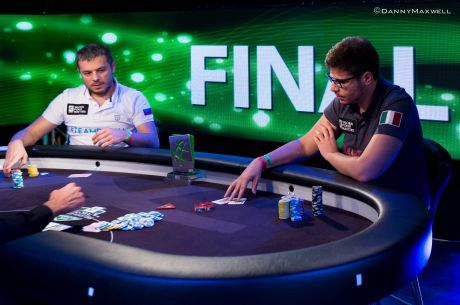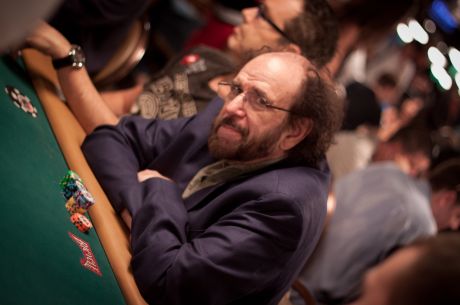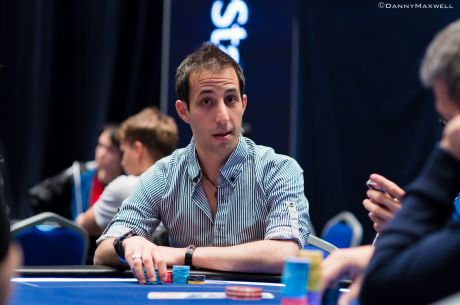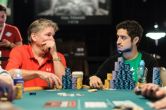Feigning Relaxation as a False Tell
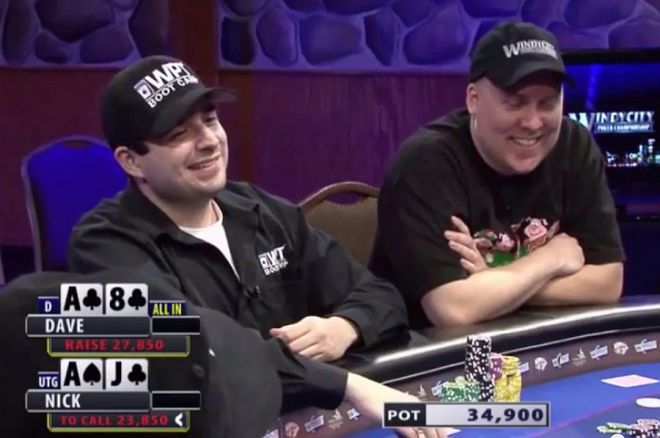
For the last few months I’ve been working on a new poker tells video series. The series uses footage from Chicago’s Windy City Poker Championships, and features both cash games and tournaments.
Before releasing the videos, I provided some of the regular players in those Chicago games free access to the videos as a small thank-you for letting me using their footage. One of the players I shared the videos with was Dave Backstrom, a Chicago-area player who has been playing for more than eight years.
Dave and I talked via email and had an interesting discussion about feigning relaxation. Dave had had some experience — some successful, some not so successful — trying to act relaxed when making a significant bluff. And as it happens, several of these situations were captured on video. So in this article we’ll examine these hands and talk about:
- The wisdom of trying to feign relaxation when making a significant bluff.
- Factors involved in determining if a player is genuinely relaxed or just acting relaxed.
Thanks to Dave for allowing me to talk about these hands and share our discussion.
Hand #1: Acting Relaxed at the WSOP Main Event
The first hand Dave and I discussed was from the 2007 World Series of Poker Main Event. Here’s a synopsis of how Dave described this hand:
At times I’ve experimented with giving off false tells. As you know, this can be very dangerous. I played in the 2007 WSOP Main Event and had a couple well-known pros at the table, including “Miami” John Cernuto.
I got involved in a hand with him, which is available on Youtube (see below). I raised UTG with AxQx and he flatted with 7x7x, and we went to the flop heads-up. I whiffed on a flop of J♣4♠3♣ and made a large, pot-sized c-bet. The reason I bet large was because he didn’t have many chips left (about 14K), so I didn’t want to bet small to where he could bluff-jam on me, so I made a larger bet which would make it easy for me to call off if he did shove. Basically I was committing myself to the hand.
He went into the tank and I felt like he was reading my soul. This was my first time playing the Main Event and I’d only been playing poker for about a year at that point, so I was quite nervous. I felt I needed to look comfortable. At one point he said something funny, and I laughed. Soon after that, you can’t see it on the video, but I did a fake yawn, and he actually commented on it, saying, “Wow, now you look bored. Is your hand that good?"
Looking back, I realize it might have been dumb to try to throw out a false tell to a seasoned pro, but it was an interesting spot, nonetheless. He did end up folding his 7x7x.
Here’s the hand, starting at the 2:55 mark:
Dave’s motivation is understandable — he wanted to act relaxed in order to get his opponent to lay down a better hand or a hand with good equity against him.
The first question we’ll ask is: how hard is this behavior to interpret correctly? Or, to put it another way: how easy is Dave’s behavior for an opponent to figure out?
On the surface, we might be tempted to say that acting relaxed is acting strong, and therefore will usually mean a weak hand. That’s the basic strong-means-weak interpretation Mike Caro described in his classic Caro’s Book of Poker Tells many years ago. Someone acts in a manner that seems opposite of hand strength.
But, as is usual with most behavior, it’s not usually that simple or clear-cut. The truth is that, in a vacuum (i.e., not taking into account any past behavior) such behavior will often be difficult to interpret correctly, even by very good players. That’s because players who make significant bets with strong hands are also capable of seeming relaxed. We’ve all seen players with the nuts or near-nuts and acting in various relaxed ways — e.g., saying weird things, throwing chips into the pot, shrugging, and so on. So even though players with weak hands and bluffs can have a motivation to appear relaxed, players making big bets with strong hands also often just choose to let their genuine relaxation show.
This is actually a bit of a simplification. Actually, early in a hand there are a lot of “relaxed” behaviors that will make very strong hands unlikely, something I wrote about before here in “Poker Tells: A General Theory About Attention-Grabbing Behavior.” Also, there are sometimes player-specific tendencies that can make such relaxed behaviors more likely to be bluffs and weak hands. (For more on the latter, here’s a video where I analyze a player who seemed to talk more when holding weak hands.)
But for late-hand and action-ending situations, it’s true that there’s a lot of variety in how relaxed-seeming behavior shows up.
When considering that it will usually be difficult for even experienced players to determine if a bettor’s behavior is genuinely relaxed or only fake relaxed, Dave’s behavior doesn’t seem that bad, at least when taken in a vacuum. For the sake of argument, let’s have Miami John hold a stronger hand where a call is more borderline. Let’s give him Jx10x-suited (meaning he flopped top pair).
If I were Miami John and I had Jx10x here, I’d be asking myself something like: “What are the chances a random, seemingly not-very-serious poker player is faking such relaxation versus the chances that this player is actually just relaxed?”
On one hand, I would think it’d be unlikely that Dave would act in such a way with a super-strong hand, like a set, because he wouldn’t want to discourage my action. But that’s not very helpful, as I could also easily imagine an amateur player wanting just to end the hand with many hands that beat me, including overpairs and AxJx. Not that I claim to be a world-class player, but I believe most professional players would reach the same conclusion — that is, to think it’s entirely possible for such a player to be letting his genuine relaxation leak out a little bit, and that that’s equally or more possible than the chance he’s faking his relaxation.
So I think Dave’s false tell is defensible, although I’m not saying I think it’s a good idea. But I do think it’s not nearly as bad as some people might reflexively think. (Don’t underestimate how much seeing a player’s cards influences your opinion of his play or behavior.)
Of course, the value of such a false tell goes down substantially the more you use it or the more your opponents are familiar with you, but we’ll talk more about that later.
Hand #2: Feigning Relaxation Heads-Up
The second hand Dave and I discussed comes from a $365 buy-in WSOP Circuit event from 2012 in which he finished second. Here’s what he had to say about it:
I was heads-up for a circuit ring at the Horseshoe in Hammond, Indiana. I had Ax10x-offsuit in the big blind and called the button’s raise. The flop was Q♥J♠4♠. He bet and I called.
The turn came the 8♥, giving me a double gutshot. I moved all-in. He tanked, and while doing so, I got the camera’s attention and mouthed the words “one time.”
Earlier, we’d discussed using our “one times” in the tournament, and I’d mentioned that I hadn’t used mine yet. So this was a joke referring to that. My reasoning for doing this was to look comfortable and relaxed while he was tanking. I mean, there’s no way I would be joking around with the camera if I was bluffing, right?!
But he did end up making the call with second pair — Jx10x — and he held up and won the tournament. I am wondering if I out-leveled myself? Did he interpret my asking for one time as me actually having a draw and needing the one time? Or did he see through my plan and realize that I was giving a false tell and made a good call?
Also: we had already agreed to a chop for the money, so we were just playing for the ring, and a $1,650 seat to another tournament.
Here’s that hand in full:
This hand again involves Dave acting relaxed, although there are some differences.
In the first hand we looked at, Dave was implying general relaxation by laughing, smiling, yawning, and laughingly repeating Miami John’s question back to him. In this hand, though, Dave is making what I call a “hand-strength statement,” meaning his statement is saying something about the strength of his hand. By saying “One time!” Dave is implying, however jokingly, that he needs to improve his hand, so this is what I call a weak-hand statement.
In my book Verbal Poker Tells, I talk about how weak-hand statements will generally be associated with strong hands. This is mainly because bluffers hardly ever want to imply weakness about their hands. But for statements and expressions that are superficially obvious and common knowledge to both parties, this becomes less reliable a pattern.
Because “One time!” is so obviously and superficially a weak-hand statement, it’s less reliable as a weak-means-strong pattern. It could be a weak-means-strong statement, but because it’s so easily understood, it could also more easily be a reverse psychology attempt (weak-means-weak), like Dave is using it. (Some examples of superficially-obvious weak-hand statements that decent players are capable of using in a similar way with weak hands are “Okay, time for me to go home” or “Gamble!”)
In other words, because the statement is theoretically so easy-to-understand as an attempt to appear relaxed and to influence an opponent’s decision, it becomes more likely that an opponent may see through the behavior. For this reason, I think this kind of attempt at manipulation is more dangerous and less defensible than Dave’s first attempt at appearing relaxed.
In my first book Reading Poker Tells, I discussed the strategy of using false tells. There I said that if you were going to use false tells, you’d usually want to use them when the following two conditions were met:
- Your opponent doesn’t know you well. This is because players who are familiar with your play are more likely to understand what you’re capable of, which can lead to a guessing game situation or, worst-case, your opponent out-leveling you.
- Your opponent is a player who’s pretty good. This is because for very inexperienced players, you’ll have no way of knowing how they’ll interpret your behavior.
For players who’ve played with you a good amount, even just for a few hours, it becomes possible they’ve figured out some patterns you have. For example, in this hand, it’s possible Dave’s opponent might have noticed that Dave was more likely to act silly or talkative when he was bluffing, while acting more stoic when strong. This is entirely possible, as it’s a somewhat common pattern. (Actually, I believe Dave’s immediate turn bet is the most interesting thing in this hand, and likely to make his range generally on the weaker side, but I don’t want to get into discussing another behavior.)
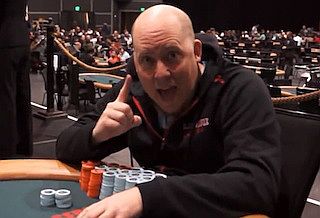
The main downside of trying to use tricky reverse tells against opponents is that it’s pretty rare that you have a good idea of how your behavior will be interpreted. For most players, especially amateur players, it’s very hard to know what they will think of a certain behavior or do with that information.
In Caro’s Book of Poker Tells, he describes amateur players having a “calling reflex.” Most players came to gamble and put their chips in the pot, he explains, and they are looking for excuses to do just that. You might be putting on an ingenious act that many decent players would interpret as strength, but an inexperienced player might just think, “He’s doing something weird, he must be bluffing” and call you. There may not be much thought involved — it could just be you triggered his “calling reflex.” This is why Caro advises staying stoic when bluffing, which I think is good advice.
Caro also advises doing strange things when value-betting, though, for the same reason — that is, trying to trigger an opponent’s calling reflex. While I think that tactic could have value when playing against very weak amateur players, I think it has questionable value versus most somewhat decent players, and potentially huge negative value when playing good players.
In the hand we just looked at, Dave said that he and his opponent had already agreed to split the money and play for the title and a relatively small buy-in to another tournament. This makes it even more likely that his opponent might just decide to call with a weak holding and try to be somewhat of a hero. In other words, the calling reflex was even more of a factor here, with the money no longer really being an issue.
In Reading Poker Tells, I also talked about how someone’s false tells, if they’re not careful, can become their actual tells. For example, players trying to look “weak” when betting a strong hand might do things like slumping in their chair, making their facial expression worried, or looking timidly back and forth at their opponent. But if that player is only engaging in such weird behavior when betting a strong hand, and is remaining stoic and neutral when betting weak hands and bluffs, an observant opponent might be able to differentiate those spots. And voila — the player’s false tell has become a real tell.
Hands #3 and #4: Feigning Relaxation after Preflop Shoves
Finally, let’s look at two hands from a couple of Windy City Poker tournaments. The first is a hand from 2012 I used in one of my poker tells video courses, a course called “Talking From Pre-Flop Raisers.”
In this hand, you’ll see Dave shove with 7x5x-suited and, as a player thinks, he says with a smile, “We’ve got a thinker.”
Again, in this hand, it seems Dave is trying to feign some relaxation with his casual “We’ve got a thinker” statement.
Now let’s look at a similar hand, this one from 2011. A player in front of Dave raises, and Dave shoves about 18 BBs with Ax8x-suited. As his opponent considers, Dave does a few things that also seem aimed at trying to convey that he’s relaxed.
Dave says “That’s trouble” as his opponent asks for a count, he laughs, he goes into a comical Phil Hellmuth-like pose, then he laughs some more at his opponent’s statements.
Also interesting, from a verbal tell perspective, is how Nick says, “Your range is pretty wide, shoving on me. Dying to shove on me here? I know, I’d be dying to shove on me, too.” Dave answers that “Jerry’s the one who’s dying to shove on you,” referring to Jerry Yang sitting across the table. Dave’s response can be seen as a subtle misdirection — he’s basically implying, “Jerry might be dying to shove on you, so his range might be wide, but my range is stronger than that.” This is a strong-hand statement, and it’s less obvious than the weak-hand statement (“One time!”) we looked at earlier. More subtle hand-strength statements will be more reliable as weak-means-strong and strong-means-weak indicators.
Even though we’ve seen a lot of weak hands from Dave where he is trying to act relaxed, it’s still entirely possible Dave could be balanced with his preflop talking. I’ve admittedly only looked at a small sample of his hands. It’s still theoretically possible that he sometimes talks and jokes around in such ways with his strong hands, too. In fact, I bet he’s cognizant enough to attempt sometimes to be balanced and do these things with strong hands.
But I also think it’s likely that Dave has a pattern of talking, laughing, smiling, and generally joking around more with his weaker hands and bluffs than with his strong hands. In other words, it’s likely he’s quite imbalanced as to when he chooses to do these kinds of things.
Dave’s final statement about all of this was: “I’m probably guilty of making this a pattern.”
Conclusion: Use False Tells Sparingly
In conclusion, I think using false tells should be done sparingly. You simply don’t often know how the behavior will be interpreted, and will usually just be throwing a confusing wrench into the works. Worst-case scenario, your opponent may see through your act.
False tells do have their place, and some people claim to get a lot of use out of them. But I look at them as things to use when the stars align in the right way, and the situation is perfect, which will hardly ever seem to be the case. For the most part, I think it’s best to just be playing your normal, hopefully behaviorally-balanced game.
Zachary Elwood is the author of the books Reading Poker Tells and Verbal Poker Tells, available in paperback and e-book formats via via Elwood's website. He recently released a new poker tells video series, available at www.readingpokertells.video.
Footage: ESPN/WSOP, WSOP, Windy City Poker.
Want to stay atop all the latest in the poker world? If so, make sure to get PokerNews updates on your social media outlets. Follow us on Twitter and find us on both Facebook and Google+!

